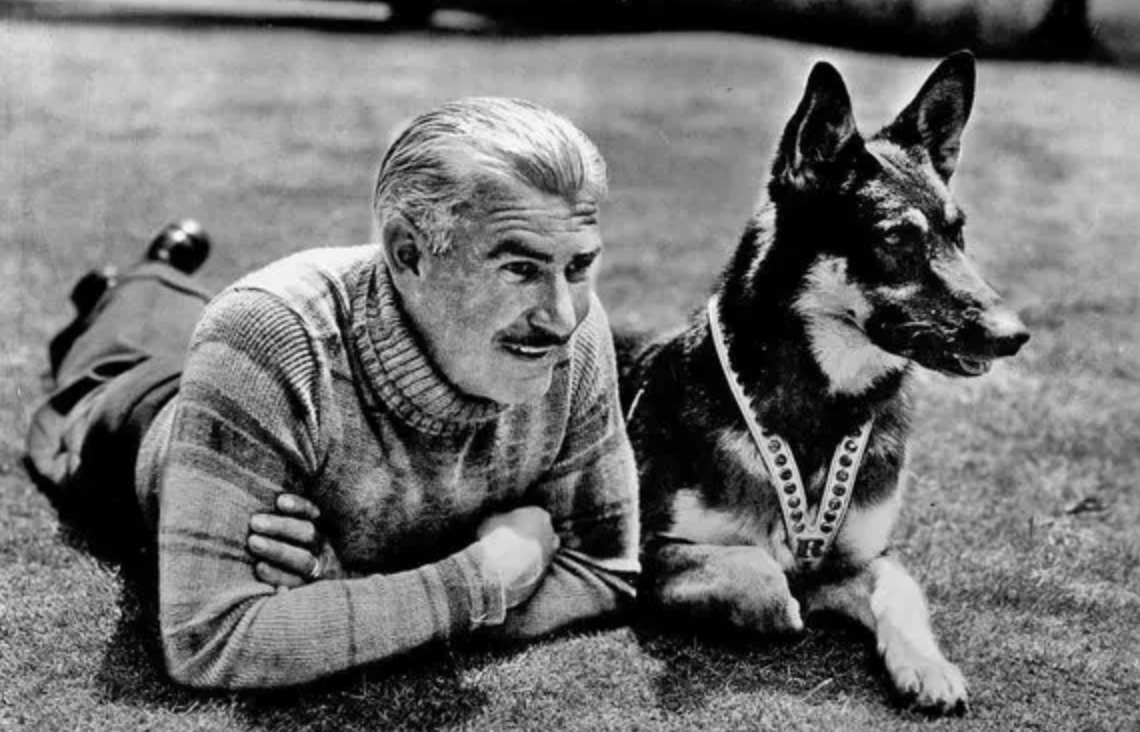HOLLYWOOD'S TOP DOG -- RIN-TIN-TIN
In the fall of 1918, as American “doughboys” fought on the Western Front, a soldier scouted a bombed out French village. Corporal Lee Duncan was picking through the rubble when he spotted a long, low building. A kennel. Inside, Duncan’s soul sank as he walked past cages of dead dogs. Then from beyond the carnage, a whimper. . .
Five German shepherd puppies huddled around their mother. It took Duncan an hour to coax the traumatized dogs into his car. Back with his brigade, Duncan gave away mother and three pups but kept two. He named them for the good luck dolls that French children handed to Allied soldiers — Nanette and Rin-tin-tin.
America has many canine legends. Lassie. Lad. Balto. But none match the celebrity of “Rinty.” Rin-tin-tin has a star on Hollywood’s Walk of Fame. Texas has a Rin-tin-tin museum. When the first Oscars were given in 1929, the Academy had to take a second vote in order to be taken seriously. Seems the first winner for Best Actor was... may I have the envelope please? In 27 movies — but that’s getting ahead of the story.
Lee Duncan was a loner. When his father left the family, Duncan and his sister were dropped off at an orphanage in Oakland, California. By the time his mother returned, three years later, the boy had a lifelong distrust of people and a lifesaving love of animals. So when he found puppies on the Western Front, Duncan “felt there was something about their lives that reminded me of my own life.”
Duncan smuggled both dogs onto the ship taking him home. By the time they reached California, Nanette had died of pneumonia but Rin-tin-tin had grown into a mighty member of a breed rarely seen in America. German shepherds had only been bred for two decades and Americans were soon smitten.
At dog shows, Rin-tin-tin turned heads. He could scale a 12-foot wall. He was quick, responsive, almost human in his understanding. At one show, a young screenwriter named Darrell F. Zanuck filmed the dog, then sold the clip to a director and paid Duncan $350. Sensing fame and fortune, Duncan began taking Rinty to studios. Lights! Camera! Fade to whirling headlines. . .
In 1923, “Where the North Begins” told a Jack London story of an abandoned dog raised by wolves. The film made a fortune. A star was born. For the rest of the 1920s, Rin-tin-tin was bankable box office. In movie after movie, the dog fought crime, rescued damsels, won hearts. Rinty’s onscreen names were homespun — Buddy, King, or Scotty -- but whether in “Tracked in the Snow Country” or “The Clash of the Wolves,” the name Rin-tin-tin was above the title.
Before silents surrendered to sound, Rin-tin-tin was earning $6,000 a week. The dog received bags of fan mail, keeping publicists busy sending out photos, each stamped with a pawprint. Millions regarded Rin-tin-tin as we all do our own pooches. “He is a human dog,” one fan wrote, “human in the real big sense of the word.”
“. . . a gentleman, a scholar, a hero, a cinema star.”
But celebrity is fleeting, especially when measured in dog years. One summer day in 1932, Lee Duncan was at El Rancho Rin-tin-tin when he heard a yelp. Rushing to Rinty, he found the dog dying. Bulletins flashed. Press agents said the dog died in the arms of star Jean Harlow, who had one of Rinty’s puppies. The obituary made the New York Times. It could have been curtains for a career, except for those puppies.
Rin-tin-tin Jr. made 14 forgettable movies. Rin-tin-tin III shunned the spotlight, content to help Duncan train army dogs during World War II. Might Rin-tin-tin IV restore the family name? Tapping the 1950s mania for TV Westerns, “The Adventures of Rin-tin-tin” put Rinty in a cavalry troop. The show, and its merchandising — Rin-tin-tin bugles, guns, mess kits — lasted five years. Duncan died in 1960, shortly after Rin-tin-tin’s star was stamped into that Hollywood sidewalk.
America’s most beloved dog still wags his tail. There have been cartoons, a children’s film, and the American Humane Society’s first Dog Hero award. The pedigree, and a trademark, now belong to a Texas woman whose pup, sent by Duncan before his death, created “a living legacy of Rin-tin-tin dogs in Houston.”
In 2011, Rin-tin-tin earned that crown of celebrity, a biography. New Yorker writer Susan Orlean recapped the story from battlefield to Hollywood to legend. Rin-tin-tin, Orlean wrote, “has always been more than a dog. He was an idea and an ideal — a hero who was also a friend, a fighter who was also a caretaker, a mute genius, a companionable loner.” But the final word should go to Lee Duncan: “There will always be a Rin-tin-tin.”
















